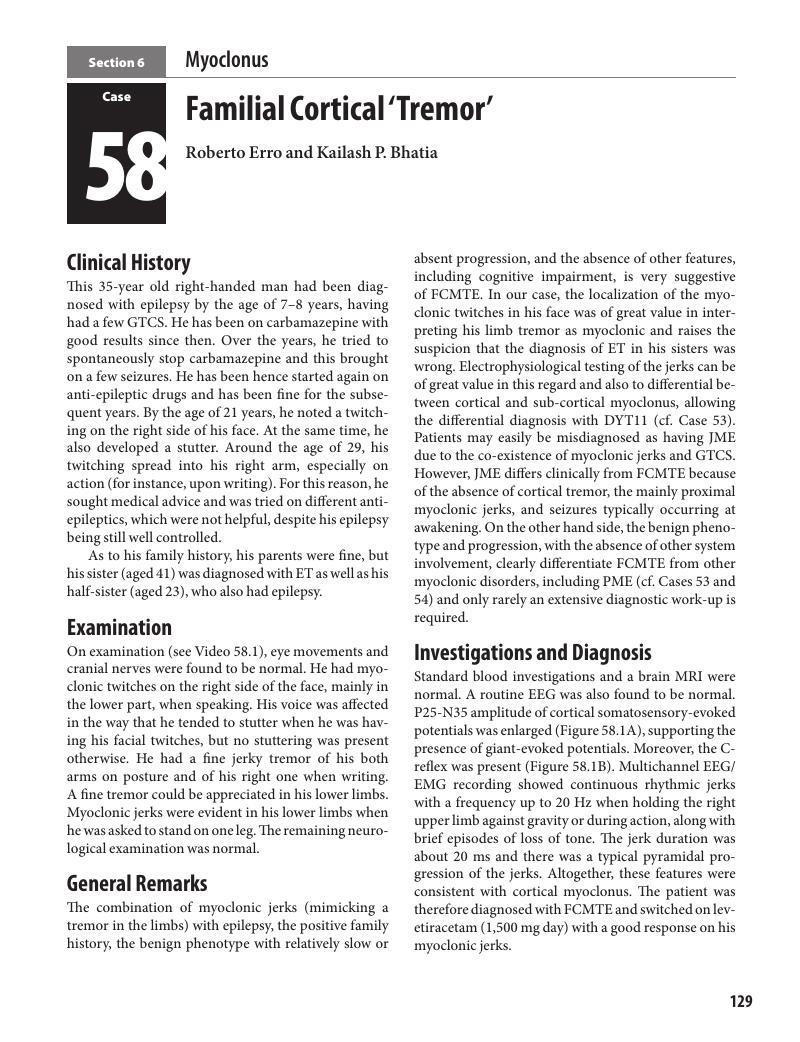Book contents
- Case Studies in Movement Disorders
- Case Studies in Movement Disorders
- Copyright page
- Contents
- Video Captions
- Contributors
- Preface
- Previously Published Cases
- Abbreviations
- Section 1 Parkinsonism
- Section 2 Dystonia
- Section 3 Tics
- Section 4 Chorea
- Section 5 Tremor
- Section 6 Myoclonus
- 52 A Case of Myoclonus-Dystonia
- 53 Progressive Myoclonic Ataxia and Unverricht-Lundborg Disease
- 54 North Sea Myoclonus Due to GOSR2 Mutations
- 55 Progressive Myoclonic Ataxia and Coeliac Disease
- 56 Asymmetric Myoclonus and Apraxia: Corticobasal Syndrome
- 57 Rapidly Progressive Cognitive Regression and Myoclonus: New Variant CJD
- 58 Familial Cortical ‘Tremor’
- 59 Prominent Myoclonus and Parkinsonism in MSA
- 60 Functional Axial Myoclonus
- Section 7 Ataxia
- Index
- Plate section
- References
58 - Familial Cortical ‘Tremor’
from Section 6 - Myoclonus
Published online by Cambridge University Press: 04 July 2017
- Case Studies in Movement Disorders
- Case Studies in Movement Disorders
- Copyright page
- Contents
- Video Captions
- Contributors
- Preface
- Previously Published Cases
- Abbreviations
- Section 1 Parkinsonism
- Section 2 Dystonia
- Section 3 Tics
- Section 4 Chorea
- Section 5 Tremor
- Section 6 Myoclonus
- 52 A Case of Myoclonus-Dystonia
- 53 Progressive Myoclonic Ataxia and Unverricht-Lundborg Disease
- 54 North Sea Myoclonus Due to GOSR2 Mutations
- 55 Progressive Myoclonic Ataxia and Coeliac Disease
- 56 Asymmetric Myoclonus and Apraxia: Corticobasal Syndrome
- 57 Rapidly Progressive Cognitive Regression and Myoclonus: New Variant CJD
- 58 Familial Cortical ‘Tremor’
- 59 Prominent Myoclonus and Parkinsonism in MSA
- 60 Functional Axial Myoclonus
- Section 7 Ataxia
- Index
- Plate section
- References
Summary

- Type
- Chapter
- Information
- Case Studies in Movement DisordersCommon and Uncommon Presentations, pp. 129 - 130Publisher: Cambridge University PressPrint publication year: 2017



